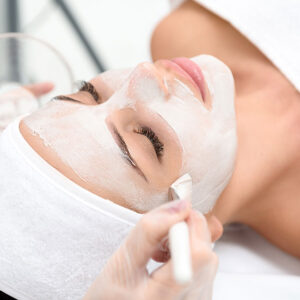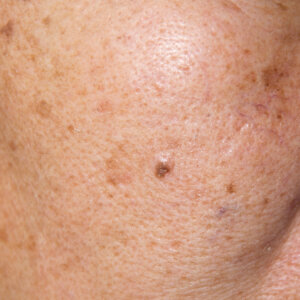Pigmentation is a broad term. It is a general collective term for dark discoloration of the skin which generally occurs due to an overproduction of pigment in the skin.
Origin
Pigmentation spots can also be caused by illness or by the use of medication that stimulates this. Pigmentation spots can occur after an inflammatory reaction such as after acne or wounds. This is also called post-inflammatory hyperpigmentation. Pigmentation spots can also occur due to excessive exposure to sunlight, such as Age Spots (lentigo solaris). These spots are often seen on the face, hands and cleavage.
Pigment is a substance (melanin) made by pigment cells deep in the epidermis. Sunlight increases the number of active pigment cells and the production of pigment. The cells package pigment in small granules and transfer it to the upper layer of the epidermis. When the pigment granules are in the upper layer, they are visible.
There are many types of pigment spots with different causes.
The following are distinguished:
- Hyperpigmentation: Are caused by an overproduction of melanin and can occur anywhere in the body. The most common cause is often sun damage.
- Age Spots: Are caused by sun damage in the past and manifests itself in Age Spots later in life. They occur on areas exposed to the sun such as the back of the hand, feet, face, neck and cleavage.
- Trauma: A pigment spot can also be caused by damage such as acne, eczema or wounds in the past. People with dark skin have a higher risk of pigmentation.
- Post-inflammatory hyperpigmentation: Post-inflammatory hyperpigmentation is a flat dark discoloration on the skin that occurs after inflammation or damage to the skin. The spots appear for example as a result of eczema, acne, psoriasis or insect bites and occur in both men and women. These spots can disappear by themselves.
- Melasma (pregnancy mask): Melasma is a pigment disorder that particularly affects pregnant women. It is caused by hormonal fluctuations during pregnancy or by the contraceptive pill. The female hormones oestrogen and progesterone stimulate pigment production in the cells, which can cause (dark) brown spots in the skin.
- Hypopigmentation: In contrast to dark pigmentation spots during hyperpigmentation, you can also have too little pigment or miss out on pigment altogether. This is also called depigmentation. The pigment is then gone on some parts of the skin. You can recognise this by white spots on the skin. Causes of this can be psoriasis or eczema. It can also be permanent such as vitiligo or albinism.
Treatment
Fortunately, there are different possibilities for treating pigmentations. The more superficial the pigment, the better it can be treated. Deeper pigmentation takes more time.
Laser therapy
Pigmentation marks can excellently be treated by our laser therapy, IPL is used for this. The pigment in the skin absorbs the light of the laser, which is converted into heat. This gives a controlled and desired tissue damage, the pigment is tackled and removed. More information can be found on the heading Laser Therapy Pigment Stains.
Peelings
In addition, we can treat pigmentations with peelings and our Image Skincare products. This inhibits the formation of pigment. In combination with home products, beautiful results are achieved, pigmentation spots become lighter or disappear completely. A peeling treatment is often carried out as a pre-treatment for a laser treatment of the pigment for optimal results. More information can be found in the heading Peelings.
- Safe & effective
- Experienced skin therapists
- High-quality lasers
- Open 7 days a week
- Always the same practitioner






